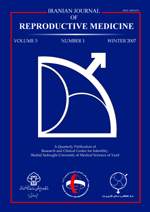
|
International Journal of Reproductive BioMedicine
Research and Clinical Center for Infertility, Shahid Sadoughi University of Medical Sciences of Yazd
ISSN: 1680-6433
EISSN: 1680-6433
Vol. 17, No. 7, 2019, pp. 481-486
|
 Bioline Code: rm19051
Bioline Code: rm19051
Full paper language: English
Document type: Research Article
Document available free of charge
|
|
|
International Journal of Reproductive BioMedicine, Vol. 17, No. 7, 2019, pp. 481-486
| en |
The effect of catheter rotation during its withdrawal on frozen thawed embryo-transfer cycles outcomes: A Case-control study
Eftekhar, Maryam; Saeed, Lida & Hoseini, Masrooreh
Abstract
Background: Embryo transfer (ET) is the last and the most clinical process in assisted
reproductive technology cycle. It has been suggested that cervical mucus interacts
with an adequate embryo transfer in different ways. A few studies showed that
catheter rotation could discharge mucus entrapped in the embryo to neutralize embryo
displacement.
Objective: The aim of this present study was to compare the outcome of frozen embryo
transfer (FET) based on catheter rotation during withdrawal.
Materials and Methods: In this case-control study, the clinical documents of 240
women who experienced frozen embryo transfer cycles were reviewd. The subjects
were divided into two groups (n = 120/each), including A) the rotation treatment group
(360°) that underwent ET using catheter rotation and B) the control group including
the subjects who experienced ET with no catheter rotation. Clinical and chemical
pregnancies and implantation rates were compared between two groups.
Results: Results showed that there is no significant difference between the basic
clinical and demographic features of both groups (p > 0.05). A significant difference
was observed in terms of the rate of chemical pregnancy between groups (21.7%
vs 43.3%, p = 0.001 respectively). In addition, the rate of clinical pregnancy was
significantly higher in study group than the control (33.35% vs 14.2%, p = 0.002
respectively).
Conclusion: Our results demonstrated that catheter rotation during withdrawal
increased the implantation rate and clinical pregnancy.
Keywords
Embryo transfer; Assisted reproductive technique; Implantation; Pregnancy.
|
| |
© Copyright 2019 -
Alternative site location: http://www.ijrm.ir
|
|
